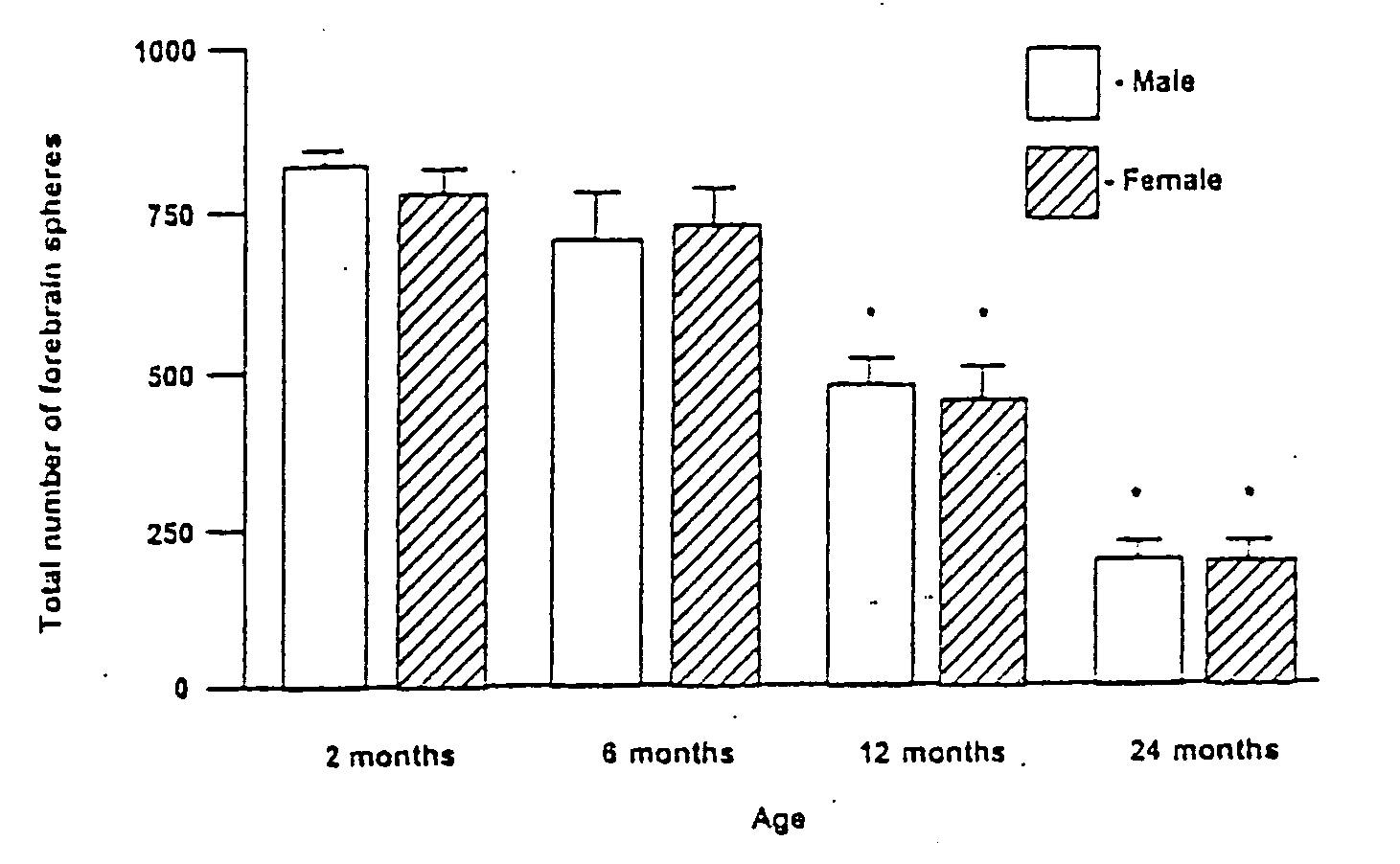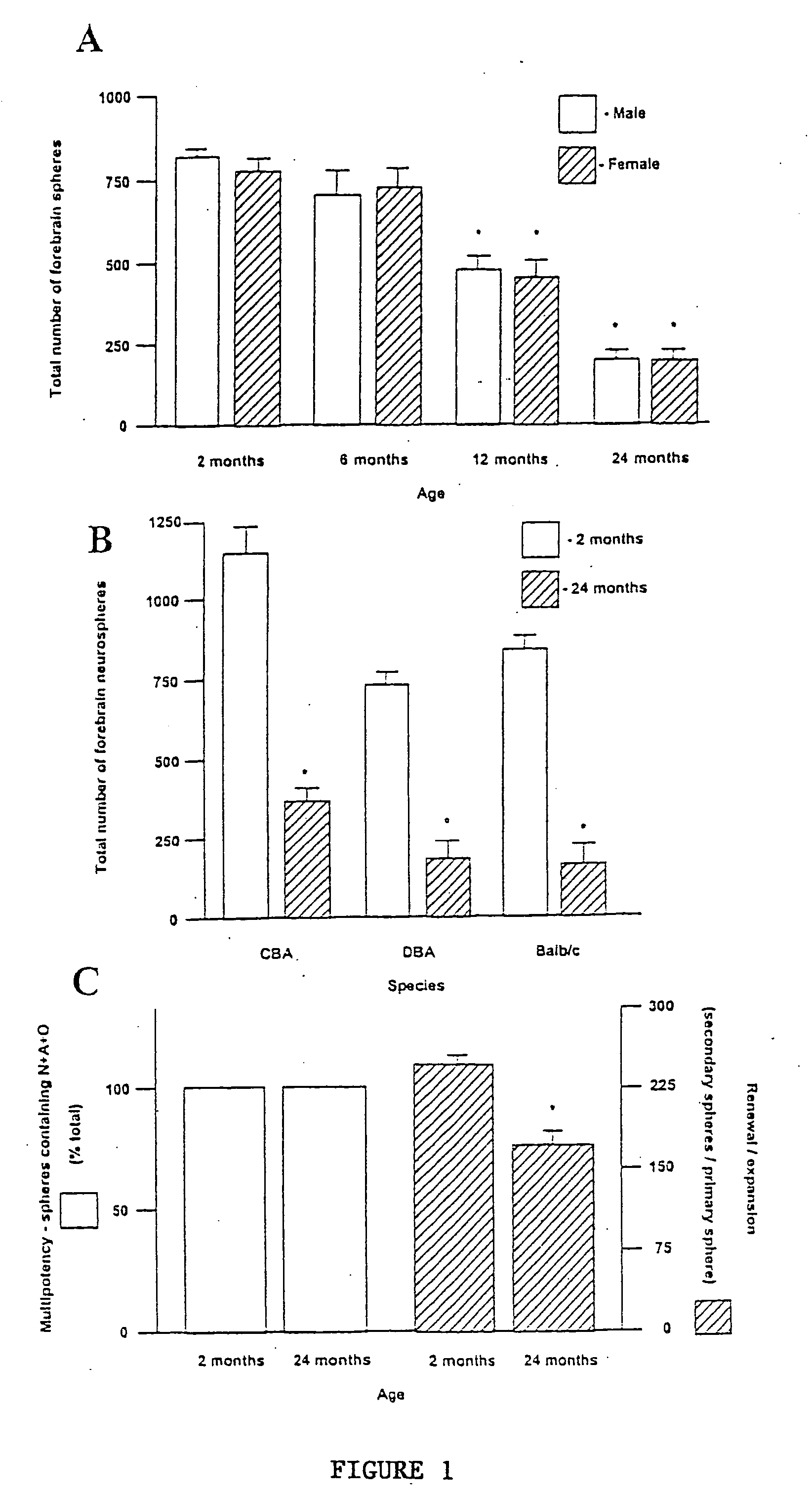Effect of growth hormone and IGF-1 on neural stem cells
a neural stem cell and growth hormone technology, applied in the field of neural stem cell effects of growth hormone and igf1, can solve the problems of loss of neural cells, inability of these cells to carry out the intended function, inappropriate functioning of the affected brain region, etc., to facilitate entry into the brain, increase the amount of endogenous factor in the mammal, and facilitate the effect of brain entry
- Summary
- Abstract
- Description
- Claims
- Application Information
AI Technical Summary
Benefits of technology
Problems solved by technology
Method used
Image
Examples
example 1
Neural Stem Cell Number Declines Significantly in Aged Mice
[0169] To determine if the number of neural stem cells is affected by aging, the entire subventricular zones of the forebrain (both hemispheres) were collected from male and female C57BL / 6J mice at various ages. The brain tissued were dissected, enzymatically dissociated and plated in defined culture medium in the presence of epidermal growth factor as described herein and in U.S. Pat. No. 5,750,376, and allowed to develop into primary neurospheres. Seven to ten days later, the numbers of neurospheres, each of which is clonally derived from a single stem cell, were counted.
[0170] The results (FIG. 1A) demonstrate that NSC numbers were reduced by 50-75% in the forebrain of aged mice (22-24 months old) in comparison to their young adult counterparts (2-4 months old). Male and female mice showed comparable reductions, indicating that the difference in sexual hormones is not the basis of this reduction.
[0171] Three other stra...
example 2
Reduced Proliferation In Vivo in Aged Mice
[0173] The reduction of NSC numbers in aged mice may be resulted from decreased proliferation of neural stem cells when the animals get older. Therefore, BrdU was infused into the brain of young adults (2 months) or aged mice (24 months), and the number of BrdU positive cells in the subventricular zone or the rostral migratory stream were determined with BrdU specific antibodies. The subventricular zone is the primary location of neural stem cells in adult mammals, and the progeny of neural stem cells, neuron precursor cells and glial precursor cells, move along the rostral migratory stream to replenish the neurons in olfactory bulbs. Therefore, the ability of cells in the subventricular zone and the rostral migratory stream to incorporate BrdU is a good indication of neural stem cell proliferative activities.
[0174] The results are summarized in Table 1. Numbers of BrdU positive cells in both the subventricular zone and the rostral migrato...
example 3
Growth Hormone Induces SVZ Proliferation In Vivo
[0175] To investigate if growth hormone is capable of inducing proliferation in the subventricular zone, where neural stem cells are primarily located in adult mammals, BrdU was infused with aCSF alone (control) or growth hormone and aCSF. The extent of BrdU incorporation was then determined with antibodies specific for BrdU. The results indicate that growth hormone significantly increased proliferation in the subventricular zone. Moreover, growth hormone also induced the newly-generated cells to migrate into the striatum.
PUM
| Property | Measurement | Unit |
|---|---|---|
| size | aaaaa | aaaaa |
| concentrations | aaaaa | aaaaa |
| pharmaceutical compositions | aaaaa | aaaaa |
Abstract
Description
Claims
Application Information
 Login to View More
Login to View More - R&D
- Intellectual Property
- Life Sciences
- Materials
- Tech Scout
- Unparalleled Data Quality
- Higher Quality Content
- 60% Fewer Hallucinations
Browse by: Latest US Patents, China's latest patents, Technical Efficacy Thesaurus, Application Domain, Technology Topic, Popular Technical Reports.
© 2025 PatSnap. All rights reserved.Legal|Privacy policy|Modern Slavery Act Transparency Statement|Sitemap|About US| Contact US: help@patsnap.com


